| Listing 1 - 10 of 10 |
Sort by
|
Book
Abstract | Keywords | Export | Availability | Bookmark
 Loading...
Loading...Choose an application
- Reference Manager
- EndNote
- RefWorks (Direct export to RefWorks)
Materials sciences --- corrosiepreventie --- CAD (computer aided design) --- corrosie
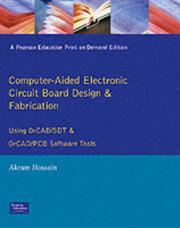
ISBN: 0130320951 Year: 2002 Publisher: Upper Saddle River Prentice Hall
Abstract | Keywords | Export | Availability | Bookmark
 Loading...
Loading...Choose an application
- Reference Manager
- EndNote
- RefWorks (Direct export to RefWorks)
Electronics --- ORCAD --- PCB (printed circuit board) --- EDA (electronic design automation) --- CAD (computer aided design) --- CAD CAM
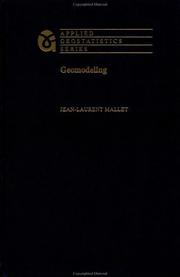
ISBN: 1280835370 9786610835379 0198033036 9780198033035 0195144600 9780195144604 9781280835377 6610835373 Year: 2002 Publisher: Oxford ; New York : Oxford University Press,
Abstract | Keywords | Export | Availability | Bookmark
 Loading...
Loading...Choose an application
- Reference Manager
- EndNote
- RefWorks (Direct export to RefWorks)
1. Discrete Modeling for Natural Objects. 2. Cellular Partitions. 3. Tessellations. 4. Discrete Smooth Interpolation. 5. Elements of Differential Geometry. 6. Piecewise Linear Triangulated Surfaces. 7. Curvilinear Triangulated Surfaces. 8. Elements of Structural Geology. 9. Stochastic Modeling. 10. Discrete Smooth Partition. Index.
Computer-aided design. --- Geology --- CAD (Computer-aided design) --- Computer-assisted design --- Computer-aided engineering --- Design --- Geognosy --- Geoscience --- Earth sciences --- Natural history --- Computer simulation. --- Geodesy. Cartography --- Geology. Earth sciences --- Artificial intelligence. Robotics. Simulation. Graphics --- CAD (computer aided design)
Book
ISBN: 9039520771 Year: 2002 Publisher: Schoonhoven Academic Service
Abstract | Keywords | Export | Availability | Bookmark
 Loading...
Loading...Choose an application
- Reference Manager
- EndNote
- RefWorks (Direct export to RefWorks)
Dit boek is bedoeld voor Werktuigbouwkundigen die voor het ontwerpen gebruik maken van het 3D CAD-pakket Autodesk Inventor. Het boek is gebaseerd op release 6, maar ook geschikt voor gebruikers van release 5. Waar nodig worden verschillen tussen beide versies duidelijk aangegeven. Autodesk Inventor is een zogenaamd Solid Modeler. Met een Solid Modeler kunt u van de onderdelen van een ontwerp denkbeeldige massieve modellen maken. Van deze Solid Models kunt u vervolgens een samenstelling maken. Vanuit de Solid Models en het geassembleerde ontwerp kunt u 2D-monotekeningen en 2D-samenstellingstekeningen genereren. Aan de hand van voorbeelden worden de gereedschappen behandeld die in Inventor beschikbaar zijn voor het genereren van Solid Models van onderdelen, het maken van samenstellingen en het onttrekken van 2D-tekeningen uit Solid Models. Ook wordt aandacht besteed aan het importeren van AutoCAD 2D-tekeningen en Mechanical Desktop modellen in Inventor. Door de vele voorbeelden, oefeningen en tips leert u effectief om te gaan met Inventor en zult u wellicht ideeën opdoen voor uw eigen ontwerppraktijk. De Inventor-bestanden van de voorbeelden en oefeningen in dit boek staan op een cd-rom (ISBN 90 395 2077 D) die bij de uitgever verkrijgbaar is.
Production management --- Programming --- Technical drawing --- computer-aided design [process] --- werktuigbouwkundig ontwerpen --- Mechanical Desktop --- Inventor (informatica) --- CAD (computer aided design)
Book
Year: 2002 Publisher: Brussel VVKSO
Abstract | Keywords | Export | Availability | Bookmark
 Loading...
Loading...Choose an application
- Reference Manager
- EndNote
- RefWorks (Direct export to RefWorks)
Didactics of technology --- Technical drawing --- frezen --- AutoCAD (informatica) --- TSO (technisch secundair onderwijs) --- CNC frezen --- technologische innovatie --- projectonderwijs --- technisch tekenen --- CAD (computer aided design)
Book
ISBN: 9090159010 Year: 2002 Publisher: Place of publication unknown Van Dorpe, Wellekens
Abstract | Keywords | Export | Availability | Bookmark
 Loading...
Loading...Choose an application
- Reference Manager
- EndNote
- RefWorks (Direct export to RefWorks)
Computer assisted instruction --- Applied physical engineering --- Programming --- Artificial intelligence. Robotics. Simulation. Graphics --- Technical drawing --- 3D computertoepassingen --- AutoCAD (informatica) --- werktuigbouwkundig ontwerpen --- digitale ontwerptechnieken --- Inventor (informatica) --- CAD (computer aided design)
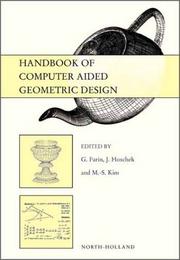
ISBN: 1281036307 9786611036300 008053340X 0444511040 Year: 2002 Publisher: Amsterdam ; Boston, Mass. : Elsevier,
Abstract | Keywords | Export | Availability | Bookmark
 Loading...
Loading...Choose an application
- Reference Manager
- EndNote
- RefWorks (Direct export to RefWorks)
This book provides a comprehensive coverage of the fields Geometric Modeling, Computer-Aided Design, and Scientific Visualization, or Computer-Aided Geometric Design. Leading international experts have contributed, thus creating a one-of-a-kind collection of authoritative articles. There are chapters outlining basic theory in tutorial style, as well as application-oriented articles. Aspects which are covered include: Historical outline Curve and surface methods Scientific Visualization Implicit methods Reverse engineering. This book is meant to be a reference te
Computer graphics. --- Computer graphics. Computer-aided design. --- Computer-aided design. --- Geometrical constructions. --- Engineering & Applied Sciences --- Technology - General --- CAD (Computer-aided design) --- Computer-assisted design --- Automatic drafting --- Graphic data processing --- Graphics, Computer --- Computer-aided engineering --- Design --- Computer art --- Graphic arts --- Electronic data processing --- Engineering graphics --- Image processing --- Digital techniques --- Computer-aided design --- Computer graphics
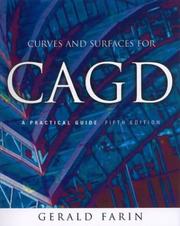
ISBN: 1558607374 9786611072902 1281072907 0080503543 9780080503547 9781558607378 661107290X Year: 2002 Publisher: San Francisco, CA ; London : Morgan Kaufmann,
Abstract | Keywords | Export | Availability | Bookmark
 Loading...
Loading...Choose an application
- Reference Manager
- EndNote
- RefWorks (Direct export to RefWorks)
This fifth edition has been fully updated to cover the many advances made in CAGD and curve and surface theory since 1997, when the fourth edition appeared. Material has been restructured into theory and applications chapters. The theory material has been streamlined using the blossoming approach; the applications material includes least squares techniques in addition to the traditional interpolation methods. In all other respects, it is, thankfully, the same. This means you get the informal, friendly style and unique approach that has made Curves and Surfaces for CAGD: A Practical G
Computer graphics. Computer-aided design. --- Computer graphics. --- Computer-aided design. --- CAD (Computer-aided design) --- Computer-assisted design --- Computer-aided engineering --- Design --- Automatic drafting --- Graphic data processing --- Graphics, Computer --- Computer art --- Graphic arts --- Electronic data processing --- Engineering graphics --- Image processing --- Digital techniques
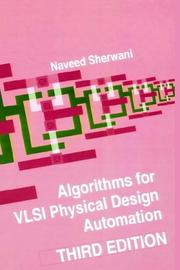
ISBN: 1280199962 9786610199969 030647509X 0792383931 Year: 2002 Publisher: New York : Kluwer Academic Publishers,
Abstract | Keywords | Export | Availability | Bookmark
 Loading...
Loading...Choose an application
- Reference Manager
- EndNote
- RefWorks (Direct export to RefWorks)
Algorithms for VLSI Physical Design Automation, Third Edition covers all aspects of physical design. The book is a core reference for graduate students and CAD professionals. For students, concepts and algorithms are presented in an intuitive manner. For CAD professionals, the material presents a balance of theory and practice. An extensive bibliography is provided which is useful for finding advanced material on a topic. At the end of each chapter, exercises are provided, which range in complexity from simple to research level. Algorithms for VLSI Physical Design Automation, Third Edition provides a comprehensive background in the principles and algorithms of VLSI physical design. The goal of this book is to serve as a basis for the development of introductory-level graduate courses in VLSI physical design automation. It provides self-contained material for teaching and learning algorithms of physical design. All algorithms which are considered basic have been included, and are presented in an intuitive manner. Yet, at the same time, enough detail is provided so that readers can actually implement the algorithms given in the text and use them. The first three chapters provide the background material, while the focus of each chapter of the rest of the book is on each phase of the physical design cycle. In addition, newer topics such as physical design automation of FPGAs and MCMs have been included. The basic purpose of the third edition is to investigate the new challenges presented by interconnect and process innovations. In 1995 when the second edition of this book was prepared, a six-layer process and 15 million transistor microprocessors were in advanced stages of design. In 1998, six metal process and 20 million transistor designs are in production. Two new chapters have been added and new material has been included in almost allother chapters. A new chapter on process innovation and its impact on physical design has been added. Another focus of the third edition is to promote use of the Internet as a resource, so wherever possible URLs have been provided for further investigation. Algorithms for VLSI Physical Design Automation, Third Edition is an important core reference work for professionals as well as an advanced level textbook for students.
Integrated circuits --- Algorithms. --- Very large scale integration --- Computer-aided design. --- Information theory. --- Systems engineering. --- Computer aided design. --- Computer engineering. --- Theory of Computation. --- Circuits and Systems. --- Computer-Aided Engineering (CAD, CAE) and Design. --- Electrical Engineering. --- Computers. --- Electronic circuits. --- Computer-aided engineering. --- Electrical engineering. --- Electric engineering --- Engineering --- CAE --- Electron-tube circuits --- Electric circuits --- Electron tubes --- Electronics --- Automatic computers --- Automatic data processors --- Computer hardware --- Computing machines (Computers) --- Electronic brains --- Electronic calculating-machines --- Electronic computers --- Hardware, Computer --- Computer systems --- Cybernetics --- Machine theory --- Calculators --- Cyberspace --- Data processing --- Computer science. --- Engineering systems --- System engineering --- Industrial engineering --- System analysis --- CAD (Computer-aided design) --- Computer-assisted design --- Computer-aided engineering --- Design --- Informatics --- Science --- Design and construction
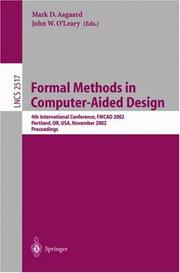
ISSN: 03029743 ISBN: 3540001166 354036126X 9783540001164 Year: 2002 Volume: 2517 Publisher: Berlin, Heidelberg : Springer Berlin Heidelberg : Imprint: Springer,
Abstract | Keywords | Export | Availability | Bookmark
 Loading...
Loading...Choose an application
- Reference Manager
- EndNote
- RefWorks (Direct export to RefWorks)
This volume contains the proceedings of the Fourth Biennial Conference on F- mal Methods in Computer-Aided Design (FMCAD). The conference is devoted to the use of mathematical methods for the analysis of digital hardware c- cuits and systems. The workreported in this bookdescribes the use of formal mathematics and associated tools to design and verify digital hardware systems. Functional veri?cation has become one of the principal costs in a modern computer design e?ort. FMCAD provides a venue for academic and industrial researchers and practitioners to share their ideas and experiences of using - screte mathematical modeling and veri?cation. Over the past 20 years, this area has grown from just a few academic researchers to a vibrant worldwide com- nity of people from both academia and industry. This volume includes 23 papers selected from the 47 submitted papers, each of which was reviewed by at least three program committee members. The history of FMCAD dates backto 1984, when the earliest meetings on this topic occurred as part of IFIP WG10.2.
Digital integrated circuits --- Integrated circuits --- Formal methods (Computer science) --- Circuits intégrés --- Méthodes formelles (Informatique) --- Computer-aided design --- Congresses --- Verification --- Design and construction --- Mathematics --- Vérification --- Congrès --- Electrical Engineering --- Electrical & Computer Engineering --- Engineering & Applied Sciences --- Circuits intégrés --- Méthodes formelles (Informatique) --- Vérification --- Congrès --- Computer science. --- Computer hardware. --- Software engineering. --- Computer logic. --- Mathematical logic. --- Computer-aided engineering. --- Electrical engineering. --- Computer Science. --- Computer-Aided Engineering (CAD, CAE) and Design. --- Computer Hardware. --- Software Engineering. --- Logics and Meanings of Programs. --- Mathematical Logic and Formal Languages. --- Electrical Engineering. --- Digital electronics --- Computer aided design. --- Logic design. --- Computer engineering. --- Informatics --- Science --- Design, Logic --- Design of logic systems --- Electronic circuit design --- Logic circuits --- Machine theory --- Switching theory --- Computer software engineering --- Engineering --- CAD (Computer-aided design) --- Computer-assisted design --- Computer-aided engineering --- Design --- Computers --- Electric engineering --- Algebra of logic --- Logic, Universal --- Mathematical logic --- Symbolic and mathematical logic --- Symbolic logic --- Algebra, Abstract --- Metamathematics --- Set theory --- Syllogism --- Computer science logic --- Logic, Symbolic and mathematical --- CAE --- Data processing --- Digital integrated circuits - Computer-aided design - Congresses --- Integrated circuits - Verification - Congresses --- Formal methods (Computer science) - Congresses --- Digital integrated circuits - Design and construction - Mathematics - Congresses --- Logic, Symbolic and mathematical.
| Listing 1 - 10 of 10 |
Sort by
|

 Search
Search Feedback
Feedback About UniCat
About UniCat  Help
Help News
News